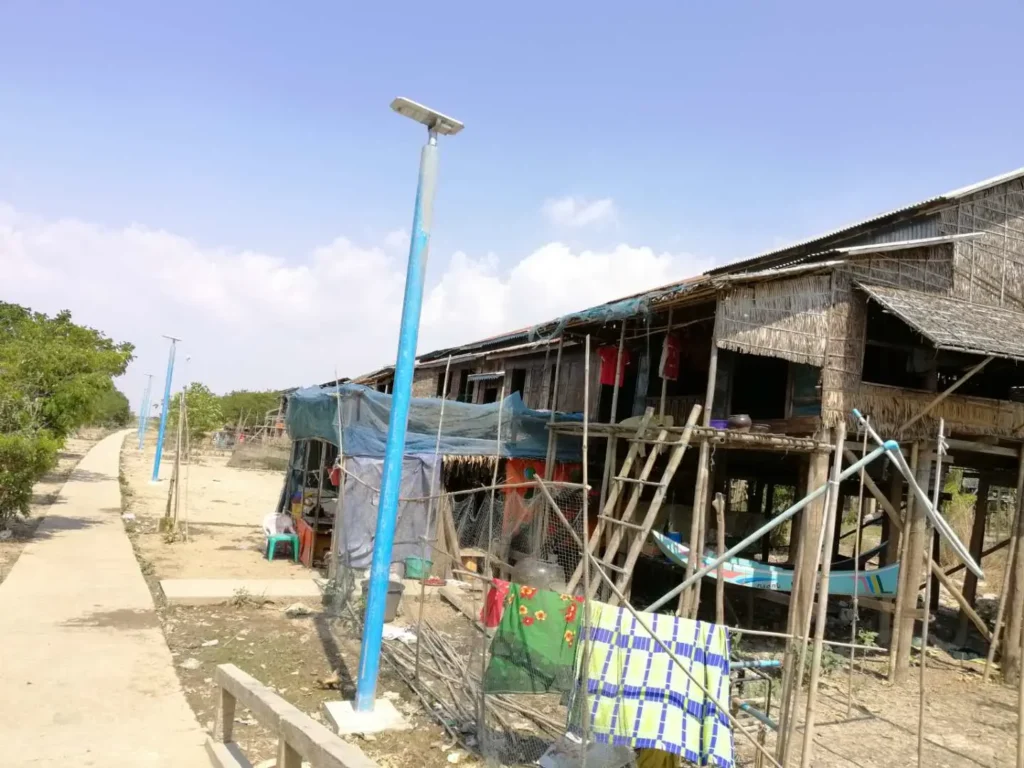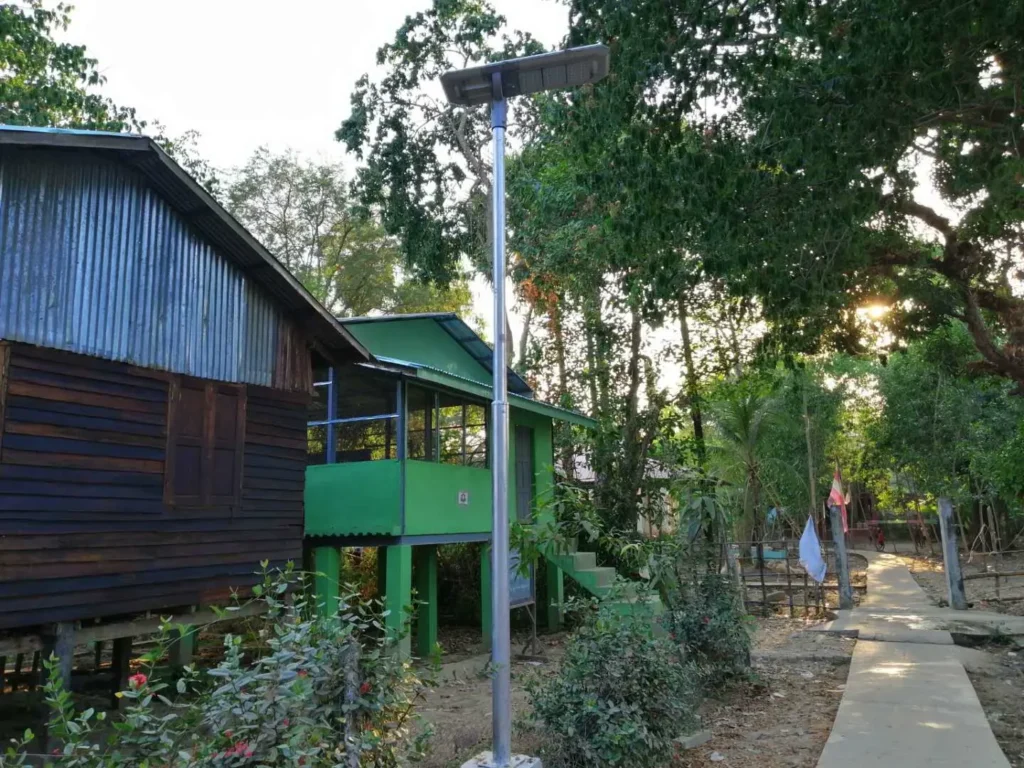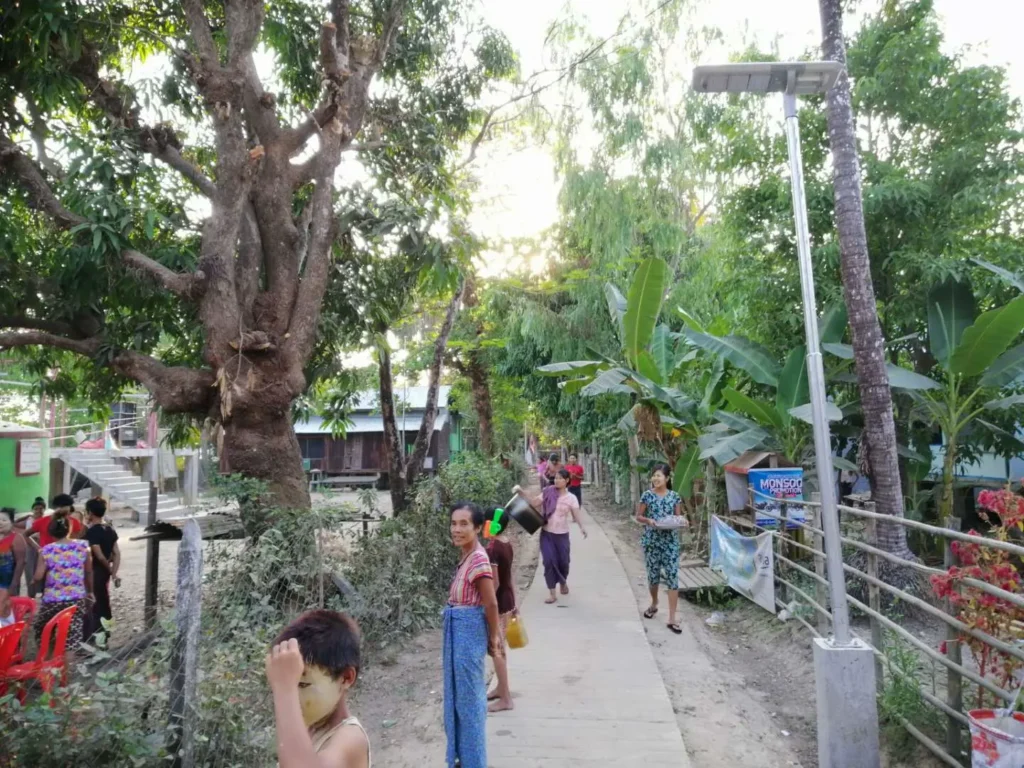Amidst the global wave of rural infrastructure upgrades, solar lighting technology has emerged as an ideal solution to address inadequate nighttime illumination in remote areas. As a leading brand in solar street lighting, SRESKY provided an efficient and economical solution for a rural region in Myanmar through its Atlas Series integrated solar streetlights.
This project successfully resolved the critical issue of poor nighttime road illumination, enhancing residents’ sense of security and community vitality while advancing green development.
I. Project Background and Needs Analysis
1.1 Project Background
This project is located in rural Myanmar, such as remote villages in the Mandalay Region or Shan State. These predominantly agricultural areas suffer from weak infrastructure, with grid coverage below 20% and virtually no nighttime road lighting. The dark environment hinders evening travel, leading to frequent traffic accidents and security incidents. It also restricts nighttime community activities like markets and social gatherings.
According to Myanmar traffic safety data, inadequate lighting accounts for 40% of nighttime accidents in rural areas.
Traditional grid-based lighting is not feasible in these regions: cable laying requires traversing complex terrain at a cost exceeding $100,000 per kilometer, with construction lasting several months. Additionally, high electricity and maintenance fees make such systems unaffordable.
The project client sought to enhance residents’ quality of life and support national sustainable development goals with modern lighting upgrades. With a proven track record in over 3,500 global projects, SRESKY emerged as the preferred partner, committed to delivering safe and economical rural road lighting solutions.
1.2 Core Requirements and Challenges
Field research and analysis identified four key requirements:
-
Grid Independence: Lighting must rely 100% on solar power with >22% charging efficiency to achieve zero electricity costs and guarantee continuous nighttime illumination.
-
High Reliability: Myanmar’s tropical monsoon climate (28–35°C average, >80% humidity, up to 2000mm rainfall) demands systems with IP65 waterproofing, IK08 impact resistance, and resilience against heat, humidity, and storms, ensuring a lifespan beyond 5 years.
-
Cost-Effectiveness: Both upfront investment and maintenance costs must be minimized. Modular product designs are required to simplify upkeep.
-
Social Value: The solution must improve nighttime safety, enable social and economic activities, and strengthen community life.
These reflect the global rural lighting market’s challenges: balancing reliability, affordability, and social benefits. The SRESKY Atlas Series addresses these needs with advanced technology.
II. Technical Solution Design
To meet rural challenges, the project adopted the SRESKY Atlas Series solar streetlights. This solution integrates high-efficiency components with smart technology to ensure cost-effectiveness and long-term stability.
2.1 Product Selection
The project deployed dozens of SRESKY Atlas Series solar streetlights (models: SSL-32A, SSL-34A, SSL-36A, SSL-38A, SSL-310A), optimized for different road types:
-
Luminous flux: 2000–10000LM
-
Mounting height: 3–10 meters
-
Spacing: 15–32 meters
-
Applications: Suitable for narrow village paths to wide rural roads
-
Design: Integrated structure, simple to install, practical for rural environments
Core Components:
-
High-Efficiency Solar Panels: Monocrystalline silicon with >22% conversion, charging time 6.7–10 hours, 20% higher efficiency than polycrystalline.
-
Long-Life Lithium Battery: >1500 cycles, reliable at -20°C to +60°C, based on EV-grade technology.
-
High-Efficiency LEDs: OSRAM chips (5700K, Ra>70, 230lm/W), Type II light distribution for uniform illumination without dark zones.
2.2 Core Technology Highlights
-
ALS 2.3 Adaptive Lighting System: Predicts weather, monitors batteries, and adjusts brightness (25–100%) for up to 10 days of continuous lighting—30% longer runtime than standard lights, ideal for Myanmar’s rainy season.
-
PIR Motion Sensor: 120° detection, 8m range. Modes: M1 (30% + 100% motion), M2 (100% 5h + 25%+PIR + 70% until dawn), M3 (70% constant). Achieves >70% energy savings.
-
TCS Smart Temperature Control: Real-time thermal management prevents battery degradation in >35°C heat, ensuring stable operation across -20°C to +60°C.
-
Durability & Modular Design: IP65, IK08, aluminum alloy + PC body, dual anti-rust protection. Modular pole-mounted components allow maintenance in <20 minutes.
These innovations make the Atlas Series highly competitive for rural tenders worldwide.
III. Project Implementation and Deployment
The project was executed within two weeks, ensuring efficiency and minimal community disruption.
3.1 Planning and Design
Installation spacing and pole height were calculated for rural roads (2–10m width, ~2km length). Illumination software ensured uniform coverage without dark spots.
3.2 Equipment Transportation
All equipment was delivered via land transport in moisture-proof, impact-resistant packaging, arriving safely with zero loss.
3.3 Installation and Construction
The integrated design simplified installation:
-
Excavate foundations and pour C20 concrete for cages
-
Bolt lamps and brackets to poles
-
Hoist onto foundations
-
Secure base flanges
Each unit took <30 minutes to install. No trenching or wiring was required, minimizing environmental disruption.
3.4 Commissioning and Operation
Each lamp was tested: ALS, PIR, and modes were verified. LED indicators (red <30%, orange 30–70%, green >70%) displayed battery levels. Acceptance confirmed 100% coverage.
IV. Project Outcomes and Impact
4.1 Significant Social Value
-
Community Safety: Accident risks reduced by 40%. Residents reported a 30% rise in perceived safety.
-
Quality of Life: Enabled night markets and social gatherings. Residents used lighted areas as gathering points, boosting vitality.
4.2 Economic and Environmental Benefits
-
Sustainability: 100% solar operation reduced CO₂ emissions by >10 tons annually, supporting Myanmar’s green goals.
-
Cost Savings: Zero electricity bills saved >$50,000 annually. Modular design + 3-year warranty minimized maintenance, with ROI in 3 years.
4.3 Technological and Brand Impact
The SRESKY Atlas Series proved highly adaptable and cost-effective, earning recognition from both communities and government as a benchmark rural lighting solution.
Summary
The Myanmar Rural Road Solar Lighting Project highlights the exceptional performance of the SRESKY Atlas Series in remote environments. Efficient deployment not only enhanced safety and community vitality but also supported green development.
This case provides valuable insights for global rural infrastructure upgrades, proving that solar lighting delivers economic, environmental, and social benefits.
👉 If you are planning a similar project, visit the SRESKY website to connect with our expert team—and illuminate your green future together!
Table of Contents


